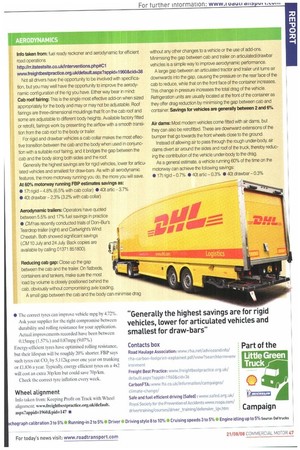Info taken from: fuel ready reckoner and aerodynamic for efficient
Page 47

If you've noticed an error in this article please click here to report it so we can fix it.
road operations http://mitstestsite.co.uldinterventions.php#C1 www.freightbes1practice.org.uk/defaultaspx?appid=1960&cith38 Not all drivers have the opportunity to be involved with specification, but you may well have the opportunity to improve the aerodynamic configuration of the rig you have. Either way bear in mind: Cab roof fairing: This is the single most effective add-on when sized appropriately for the body and may or may not be adjustable. Roof fairings are three-dimensional mouldings that fit on the cab roof and some are adjustable to different body heights. Available factory fitted or retrofit, fairings work by presenting the airflow with a smooth transition from the cab roof to the body or trailer.
For rigid and drawbar vehicles a cab collar makes the most effective transition between the cab and the body vi/nen used in conjunction with a suitable roof fairing, and it bridges the gap between the cab and the body along both sides and the roof.
Generally the highest savings are for rigid vehicles, lower for articulated vehicles and smallest for draw-bars. As with all aerodynamic features, the more motorway running you do, the more you will save. At 60% motorway running FBP estimates savings as: • 17t rigid -4.8% (6.5% with cab collar) • 40t artic 3.7% • 40t drawbar 2,3% (3.2% with cab collar)
Aerodynamic trailers: Operators have quoted between 5.5% and 17% fuel savings in practice
• CM has recently conducted trials of Don-Bur's Teardrop trailer (right) and Cartwright 's Wind Cheetah. Both showed significant savings (CM 10 July and 24 July. Back copies are available by calling 01371 851800).
Reducing cab gap: Close up the gap between the cab and the trailer. On flatbeds, containers and tankers, make sure the most load by volume is closely positioned behind the cab, obviously without compromising axle loading.
A small gap between the cab and the body can minimise drag without any other changes to a vehicle or the use of add-ons. Minimising the gap between cab and trailer on articulated/drawbar vehicles is a simple way to improve aerodynamic performance.
A large gap between an articulated tractor and trailer unit turns air downwards into the gap, causing the pressure on the rear face of the cab to reduce, while that on the front face of the container increases. This change in pressure increases the total drag of the vehicle. Refrigeration units are usually located at the front of the container as they offer drag reduction by minimising the gap between cab and container. Savings for vehicles are generally between 2 and 6%.
Air dams: Most modern vehicles come fitted with air dams, but they can also be retrofitted. These are downward extensions of the bumper that go towards the front wheels close to the ground.
Instead of allowing air to pass through the rough under-body, air dams divert air around the sides and roof of the truck, thereby reducing the contribution of the vehicle under-body to the drag.
As a general estimate, a vehicle running 60% of the time on the motorway can achieve the following savings: • 17t rigid 0.7% • 40t artic 0.3% • 40t drawbar 0.3%












































































































































































